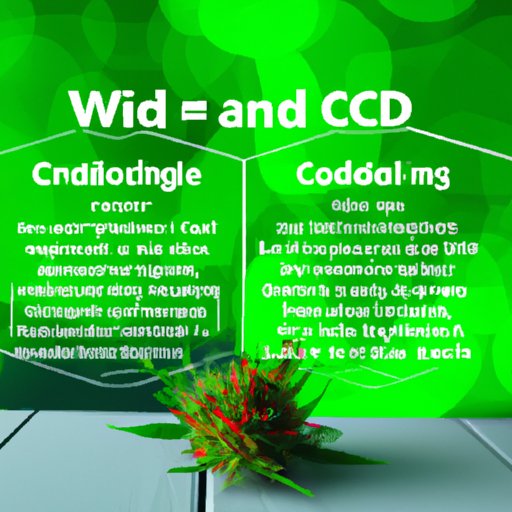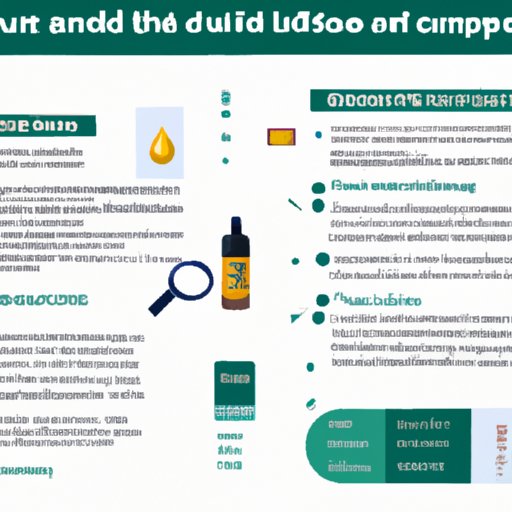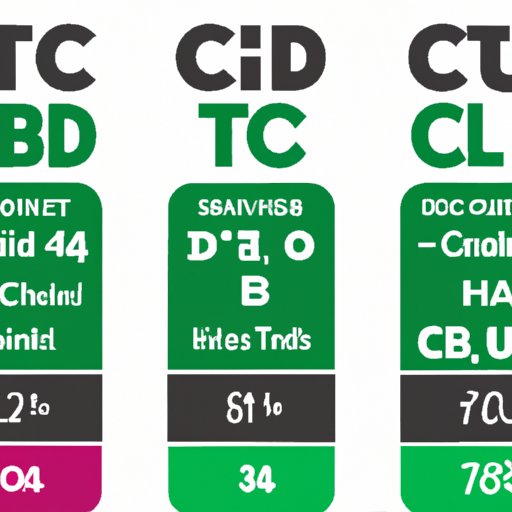I. Introduction
CBD oil, or cannabidiol, is a cannabis compound that has been gaining popularity for its potential therapeutic benefits. With the growing interest in alternative health remedies, people have been turning to CBD oil for its anti-inflammatory, pain relieving, and anxiety reducing properties. However, one of the biggest concerns when it comes to CBD oil is the amount of THC it contains. If you’re unfamiliar with THC levels in CBD oil, don’t worry, we’re here to help.
II. Understanding THC Levels in CBD Oil: What You Need to Know
THC, or tetrahydrocannabinol, is the psychoactive compound found in marijuana that produces a “high” sensation. While CBD oil is derived from the hemp plant, which contains low levels of THC, it is not completely free of THC. THC levels in CBD oil are measured in milligrams per gram of oil, or as a percentage of total weight. Most CBD oil products contain less than 0.3% THC, which is the legal limit set by the 2018 Farm Bill in the United States.
III. Is CBD Oil Safe? Analyzing THC content and Its Effects
CBD oil is generally considered safe for consumption, but it’s important to understand the role of THC in ensuring its safety. While low levels of THC are unlikely to cause any adverse effects, high levels of THC in CBD oil can result in unwanted side effects such as dizziness, dry mouth, and nausea. Additionally, consuming high levels of THC in CBD oil may lead to a positive drug test result for THC. That’s why it’s important to do your research and choose CBD oil products with a low THC content to avoid any potential risks.
IV. The THC-CBD Ratio: How to Choose the Right CBD Oil for You
The THC-CBD ratio is the amount of THC compared to the amount of CBD in a CBD oil product. The ratio can vary greatly depending on the product, with some containing high levels of THC and others containing little to no THC. Determining the right THC-CBD ratio for your needs will depend on what you’re using the CBD oil for. Those using CBD oil for pain or anxiety may benefit from a higher CBD to THC ratio, while those using CBD oil for insomnia may benefit from a higher THC to CBD ratio. It’s important to note that determining the right ratio for your needs may require some trial and error.

V. CBD Oil vs. Marijuana: Debunking the THC Myth
It’s a common misconception that CBD oil is the same as marijuana and that it produces the same “high” sensation. However, this is not the case. CBD oil is derived from the hemp plant, which contains only trace amounts of THC, compared to marijuana which contains much higher levels of THC. The legal and health implications of consuming marijuana for recreational purposes are vastly different from those of using CBD oil for therapeutic purposes. It’s important to understand the differences between the two and make informed decisions accordingly.

VI. THC and CBD: The Science Behind Their Interaction in CBD Oil
THC and CBD have different effects on the body and brain. THC is known for producing the psychoactive effects associated with marijuana use, while CBD has been shown to counteract those effects. When THC and CBD are combined in CBD oil, they can enhance each other’s therapeutic effects. CBD can also counteract any unwanted side effects of THC. The benefits of consuming different THC-CBD ratios in CBD oil will depend on your individual needs and goals.

VII. How to Read CBD Oil Labels and Identify THC Content
CBD oil labeling should include information on the THC content of the product. Look for labels that state the THC content in milligrams per gram or as a percentage of total weight. It’s important to read the label before purchasing to ensure that the product contains no more than 0.3% THC, the legal limit set by the 2018 Farm Bill in the United States.
VIII. Conclusion
Understanding THC levels in CBD oil is crucial for safe and effective consumption of this popular health supplement. When selecting a CBD oil product, take into account the THC content as well as the CBD to THC ratio. Knowing how to read CBD oil labels will help you choose the right product for your needs. While more research is needed to fully understand the effects of THC in CBD oil, we hope this guide has provided some valuable insight into the important factors to consider when choosing a CBD oil product.
